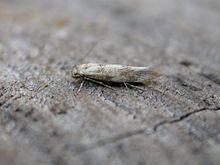You can help expand this article with text translated from the corresponding article in German. (January 2021) Click for important translation instructions.
|
| Mompha epilobiella | |
|---|---|

| |

| |
| Scientific classification | |
| Domain: | Eukaryota |
| Kingdom: | Animalia |
| Phylum: | Arthropoda |
| Class: | Insecta |
| Order: | Lepidoptera |
| Family: | Momphidae |
| Genus: | Mompha |
| Species: | M. epilobiella |
| Binomial name | |
| Mompha epilobiella (Denis & Schiffermüller, 1775) | |
| Synonyms | |
List
| |
Mompha epilobiella is a moth in the family Momphidae found in Europe and North America.
Description
The wingspan is 10–13 mm. The head is yellowish white and brownish speckled. The thorax is ochre-coloured. The forewings are also ochre and greyish on the costal vein. An indistinct yellow spot is located on the costa at 3/4 of the length of the forewing, a similar spot is on the inner angle. Two small tufts of slightly protruding dark brown scales are located at 1/5 of the length of the forewing and in the middle of the inner edge of the wing. The hind wings shine grey.
The males differ from the similar species Mompha subbistrigella by the following characteristics: The saccule is shortened and has a group of small teeth apically. The Aedeagus has a hook-shaped cornutus and several straight cornuti.
In the females, the 8th tergite is rounded at the posterior end. The bursae duct has a narrow and short posterior part and an abruptly widened anterior part. Both parts have a conspicuous sclerotized plate with strongly sclerotized edges
Adults are on wing throughout the year, but are most common in July and August in Great Britain.
The larvae have been recorded feeding on rosebay willowherb (Chamerion angustifolium), great willowherb (Epilobium hirsutum), broad-leaved willowherb (Epilobium montanum), marsh willowherb (Epilobium palustre) and evening primrose (Oenothera species), but great willowherb is the main food plant. The other listed plants might be misidentifications. Young larvae probably live as leaf miners. Older larvae live, mostly communally, in spun uppermost leaves.
Distribution
It has a Holarctic distribution, found in North America, including Ontario and all of Europe.
References
- "Mompha (Mompha) epilobiella (Denis & Schiffermüller, 1775)". Fauna europaea. Retrieved 3 May 2020.
- Meyrick, E., 1895 A Handbook of British Lepidoptera MacMillan, London pdf
 This article incorporates text from this source, which is in the public domain. Keys and description
This article incorporates text from this source, which is in the public domain. Keys and description
- Meyrick, E., 1895 A Handbook of British Lepidoptera MacMillan, London pdf
 This article incorporates text from this source, which is in the public domain. Keys and description
This article incorporates text from this source, which is in the public domain. Keys and description
- J. C. Koster, S. Yu. Sinev: Momphidae, Batrachedridae, Stathmopodidae, Agonoxenidae, Cosmopterigidae, Chrysopeleiidae. In: P. Huemer, O. Karsholt, L. Lyneborg (Hrsg.): Microlepidoptera of Europe. 1. Auflage. Band 5. Apollo Books, Stenstrup 2003, ISBN 87-88757-66-8, S. 42
- Kimber, Ian. "40.010 BF893 Mompha epilobiella ([Denis & Schiffermüller], 1775)". UKmoths. Retrieved 3 May 2020.
- Ellis, W N. "Mompha epilobiella (Denis & Schiffermüller, 1775) common mompha". Plant Parasites of Europe. Retrieved 3 May 2020.
External links


| Taxon identifiers | |
|---|---|
| Mompha epilobiella |
|
This article on a moth of the family Momphidae is a stub. You can help Misplaced Pages by expanding it. |